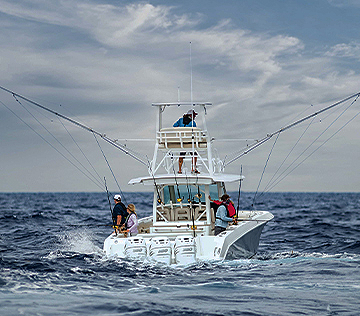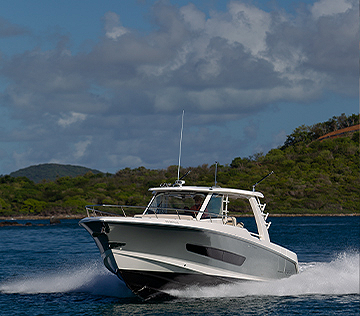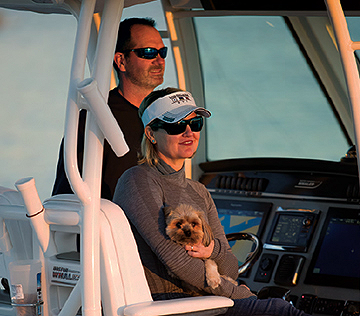
Q&A with Kevin Donnelly, Naval Architect at Boston Whaler
Essential safety tips for boating in the fall, including fog and early sunsets*.
In this exclusive interview, we sit down with Kevin Donnelly, a seasoned naval architect at Boston Whaler, to delve into the meticulous design and innovative construction processes behind their legendary boats. Get a behind-the-scenes look at how these boats are crafted to deliver unparalleled performance, durability, and ride quality, making them a favorite among boating enthusiasts for generations.
Q: How long have you been with Boston Whaler, and what is your role in the boat-building process?
Kevin Donnelly: I joined Brunswick in 2012 and moved to the Boston Whaler team in 2016 as the first advanced engineer. My role involves working upfront with industrial designers very early in a project. I became the naval architect for Boston Whaler in 2018. Naval architects are heavily involved from the start, providing hull designs that fit the desired length, beam, and depth, and refining these designs through multiple iterations to meet performance and stability goals. By the time we reach the heavy engineering phase, my work is mostly complete, and the hull design is finalized.
Q: How many hull iterations typically go into developing a new model?
Kevin Donnelly: It varies for each project. The right number is as many as needed to make the product right. Sometimes it’s just one or two iterations, other times it’s seven or eight. The goal is always to make the best product possible.
Q: Do you have a favorite project or model you've worked on?
Kevin Donnelly: My favorite project is always the one I'm currently working on. Each project has unique challenges, whether improving on a previous model or developing something entirely new. The current project excites me the most as I look forward to seeing how it performs on the water.
Q: What is unique about the hull design of Boston Whaler models?
Kevin Donnelly: The most unique element of Boston Whaler hulls is the smirk. The smirk is a characteristic inflection point in the chine, very noticeable in the boat's profile. It brings the height of the chine upward quickly in the front, creating a lot of dead rise at the entry. This design significantly contributes to the excellent ride quality our boats are known for.
Q: Can you explain the performance goals considered in the hull design?
Kevin Donnelly: As naval architects, when we design the hull, we aim to meet all performance metrics for a project. We're responsible for the entire hull, from the keel to the rub rail. This includes considerations like the boat's weight, wide-open throttle speed, handling in various sea states, and ride quality. Stability requirements set by governing bodies like ABYC and ISO are also crucial early in the design process, even before our industrial designers begin defining the boat's aesthetic.
Q: Could you describe the Unibond construction process and how it sets Boston Whaler boats apart?
Kevin Donnelly: The Unibond construction process is unique to Boston Whaler. Whether it's a small 13 Super Sport or a large 420 Outrage, the inner liner of the hull is closed to the outer hull, and the cavity is then filled with foam. This foam-filled process creates a single unified structure, providing improved stiffness, ride quality, and noise reduction. This solid construction is a key factor in the durability and longevity of Boston Whaler boats.
Q: How has the Unibond construction process evolved over time?
Kevin Donnelly: The basic essence of the process has remained consistent since Boston Whaler founder Dick Fisher patented the foam-injected hull in 1958, giving birth to the ‘Unsinkable Legend.’ However, the equipment used has become more advanced, allowing us to foam-fill large cavities quickly and efficiently. The foam, along with shear ties, holds the inner liner and hull together to create a unified structural element, contributing to the solid feel and better ride quality.
Q: Boston Whalers are known for their longevity. Is this due to the construction process?
Kevin Donnelly: Absolutely. The robust construction and quality of the hull design ensure that these boats last a lifetime. Many owners have boats from the 70s or 80s that are still in great condition with proper maintenance. The solid construction and durability of Boston Whaler boats make these ‘Unsinkable Legends’ able to perform incredibly well throughout generations.
Q: Are there any exciting innovations or developments in materials that Boston Whaler is exploring?
Kevin Donnelly: We are currently exploring ways to improve sustainability at Boston Whaler. For example, we’ve switched to using recycled feedstock for flooring material in many parts of our boats. We’re also exploring more recyclable materials for boat construction, although that development is still in progress at this time. Consistent innovation in materials and processes ensures that we continue to produce high-quality, durable boats while also considering the environmental impact.
Want to learn more about Boston Whaler’s unique design process and advancements in technology? Visit our Innovations Page to see how we’re setting new standards in the boating industry.
--
This is for general information purposes only. Your use or reliance on any of the information in this Blog is solely at your own risk. Under no circumstance will we have any liability for any loss or damage of any kind incurred as a result of the use of any of the information provided.
Options and features mentioned subject to change. Please confirm availability of all accessories and equipment with an authorized Boston Whaler Dealer.



